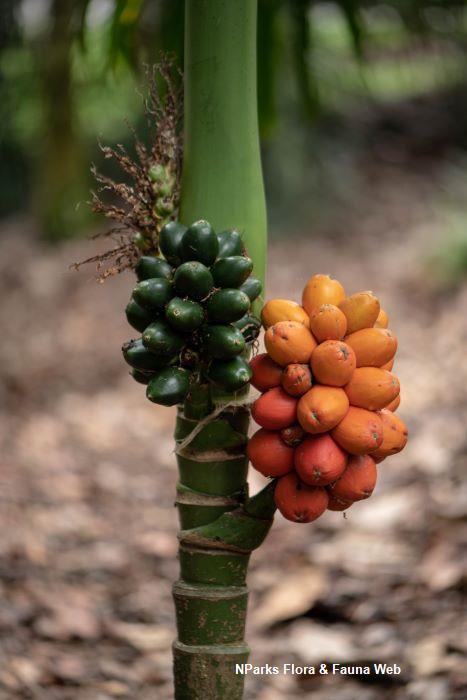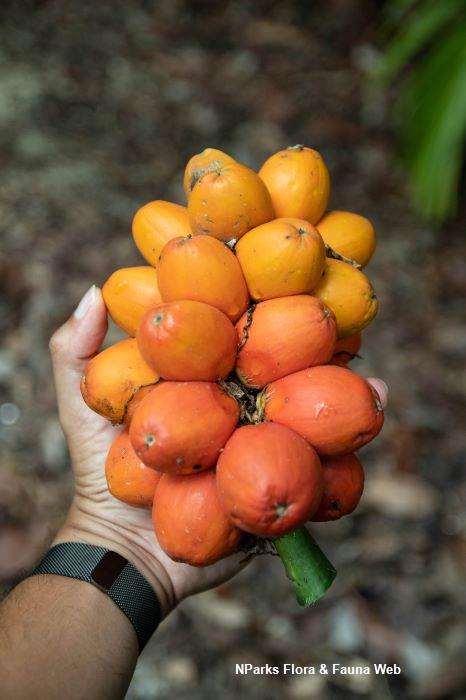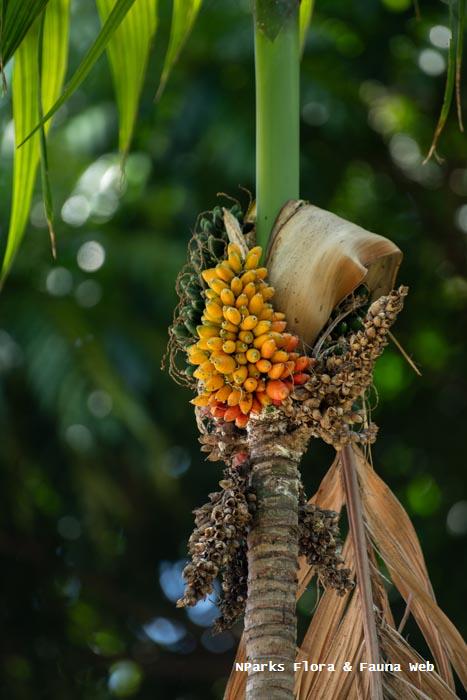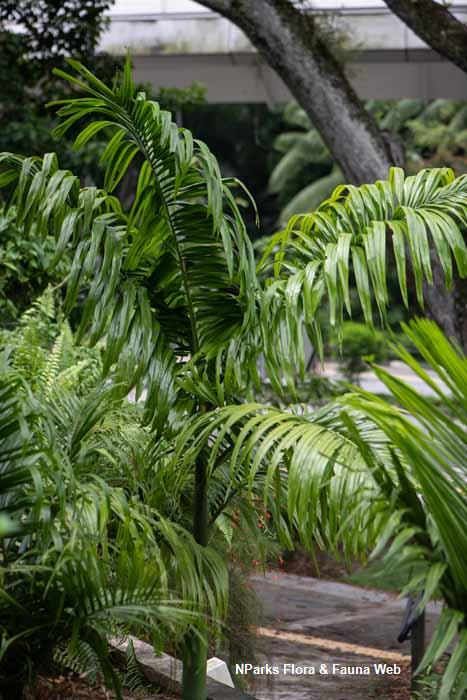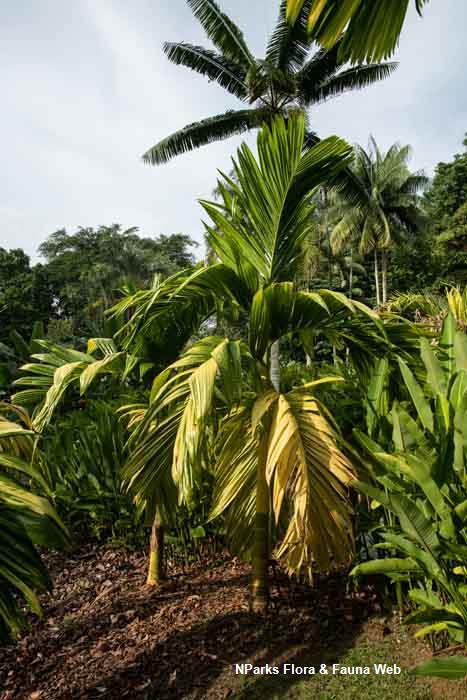
Back
Areca ipot Becc.
| Family Name: | Arecaceae (Palmae) |
| Common Name: | Ipot Palm, Bungang-ipot, Ipod, Ipot, Mangipod, Saksik, Saksig |
Areca ipot, or commonly known as Ipot Palm, is a solitary-growing understorey palm endemic to the Philippines. It resembles a smaller version of the Betel Nut Palm (Areca catechu), growing up to 4 m tall. In landscaping, it is grown as an ornamental palm for its attractive form and large, bright red and orange fruit.
Name
Classifications and Characteristics
| Plant Division | Angiosperms (Flowering Seed Plants) (Monocotyledon) |
|---|---|
| Plant Growth Form | Palm (Solitary Habit) |
| Lifespan (in Singapore) | Perennial |
| Mode of Nutrition | Autotrophic |
| Plant Shape | Fountain (Palm-like) |
| Maximum Height | 4 m |
Biogeography
| Native Distribution | Philippines (Pollillo Island, and southern parts of Luzon) |
|---|---|
| Native Habitat | Terrestrial (Primary Rainforest, Riverine) |
| Preferred Climate Zone | Tropical |
| Local Conservation Status | Non-native (Horticultural / Cultivated Only) |
Description and Ethnobotany
| Growth Form | It is a solitary-growing palm, rarely reaching up to 4 m tall. |
|---|---|
| Trunk | The trunk can reach 8 - 12 cm in diameter, and is visibly ringed with green internodes. |
| Foliage | The fronds are arching, semi-erect and pinnately-compound with broad, glossy leaflets. |
| Crown Shaft | The crown shaft is green and somewhat inflated. |
| Flowers | The inflorescence is an infrafoliar panicle, emerging below the fronds and the crown shaft and subtended by a spathe or penduncular bract. |
| Fruit | The infructescence is erect and densely clustered with fruits. The fruits are large, ovoid fleshy drupes, up to 5 cm long x 3 cm wide. The fruits ripen from green to orange to red. |
| Habitat | It can be found in tropical forests along stream sides up to 750 m above sea level. |
| Similar | This species resembles the Betel Nut Palm (Areca catechu) but can be differentiated by its shorter height and erect, densely crowded fruits. |
| Cultivation | It grows well in well-draining loam soil and shady conditions. It can be propagated by seeds. |
| Etymology | The genus epithet Areca is derived from a vernacular name by the locals of the Malabar coast of India for a species of this particular genus. The specific epithet ipot is from the Philippines vernacular name, bunga ipot, for the palm. |
| Ethnobotanical Uses | Others: The fruit is sometimes used as a inferior substitute for the Betel Nut (Areca catechu). |
Landscaping Features
| Desirable Plant Features | Ornamental Fruits, Ornamental Form |
|---|---|
| Landscape Uses | General, Parks & Gardens |
| Thematic Landscaping | Naturalistic Garden |
Plant Care and Propagation
| Light Preference | Full Sun, Semi-Shade |
|---|---|
| Water Preference | Moderate Water |
| Plant Growth Rate | Fast to Moderate |
| Rootzone Tolerance | Well-Drained Soils, Fertile Loamy Soils |
| Pest(s) | Chewing Insects |
| Propagation Method | Seed |
Foliar
| Foliage Retention | Evergreen |
|---|---|
| Mature Foliage Colour(s) | Green |
| Mature Foliage Texture(s) | Smooth |
| Foliar Type | Compound (Even-Pinnate) |
| Foliar Arrangement Along Stem | Spiral |
| Foliar Attachment to Stem | Petiolate |
| Foliar Shape(s) | Palm Fronds (Pinnate / Feather) |
| Foliar Venation | Parallel |
| Foliar Margin | Entire |
| Leaf Area Index (LAI) for Green Plot Ratio | 2.5 (Palm - Solitary) |
Non - Foliar and Storage
| Trunk Type (Palm) | Aboveground, Solitary Habit |
|---|---|
| Root Type | Underground (Fibrous Root) |
Floral (Angiosperm)
| Flower & Plant Sexuality | Unisexual Flowers , Monoecious |
| Flower Colour(s) | Cream / Off-White |
|---|
| Flower Grouping | Cluster / Inflorescence |
| Flower Location | Axillary |
| Flower Symmetry | Radial |
| Inflorescence Type | Panicle |
| Ovary Position | Superior / Hypogynous |
| Flowering Habit | Polycarpic |
Fruit, Seed and Spore
| Mature Fruit Colour(s) | Orange, Red |
|---|---|
| Mature Fruit Texture(s) | Smooth |
| Fruit Classification | Simple Fruit |
| Fruit Type | |
| Seed Quantity Per Fruit | Few (1-5) |
References
| References | Brown, W.H., Merrill, E.D. (1903). Philippine Palms and Palm Products. Department of Agriculture and Natural Resources, Bureau of Forestry (Bulletin No. 18): 20–23. Energy Development Corporation (EDC). (2020). Areca ipot. The IUCN Red List of Threatened Species 2020: e.T39026A153536542. https://dx.doi.org/10.2305/IUCN.UK.2020-3.RLTS.T39026A153536542.en. Accessed on 13 May 2025. Jones, D.L. (1995). Palms throughout the World. Smithsonian Institution Press, Washington DC: 129. |
|---|
Image Repository
Others
| Master ID | 29253 |
|---|---|
| Species ID | 3562 |
| Flora Disclaimer | The information in this website has been compiled from reliable sources, such as reference works on medicinal plants. It is not a substitute for medical advice or treatment and NParks does not purport to provide any medical advice. Readers should always consult his/her physician before using or consuming a plant for medicinal purposes. |

